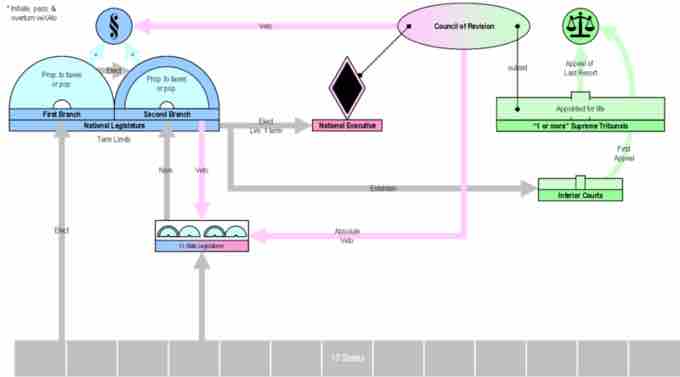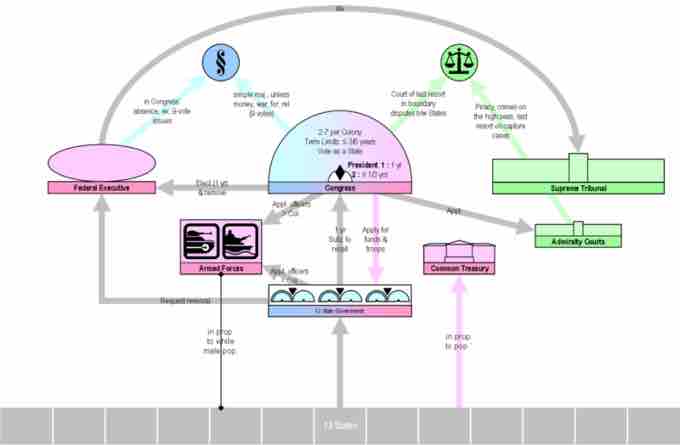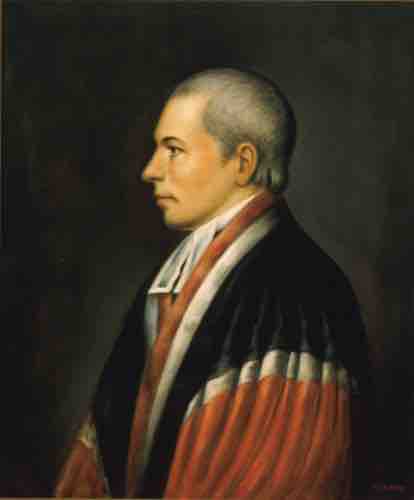Introduction
The Constitutional Convention gathered in Philadelphia to revise the Articles of Confederation. The Virginia delegation took the initiative to frame the debate by immediately drawing up and presenting a proposal, for which delegate James Madison is given chief credit. It was, however, Edmund Randolph, the Virginia governor at the time, who officially put it before the convention on May 29, 1787 in the form of 15 resolutions.
The scope of the resolutions, going well beyond tinkering with the Articles of Confederation, succeeded in broadening the debate to encompass fundamental revisions to the structure and powers of the national government. The resolutions proposed, for example, a new form of national government having three branches: legislative, executive, and judicial. One contentious issue facing the convention was the manner in which large and small states would be represented in the legislature. The contention was whether there would be equal representation for each state regardless of its size and population, or proportionate to population giving larger states more votes than less-populous states.
Virginia Plan
The Virginia Plan proposed a bicameral legislature, a legislative branch with two chambers. This legislature would contain the dual principles of rotation in office and recall, applied to the lower house of the national legislature . Each of the states would be represented in proportion to their "quotas of contribution, or to the number of free inhabitants." States with a large population would thus have more representatives than smaller states. Large states supported this plan, while smaller states generally opposed it.

Virginia Plan
Visual representation of the structure of James Madison's Virginia Plan.
In addition to dealing with legislative representation, the Virginia Plan addressed other issues as well, with many provisions that did not make it into the Constitution that emerged. It called for a national government of three branches: legislative, executive, and judicial. The people would elect members for one of the two legislative chambers. Members of that chamber would then elect the second chamber from nominations submitted by state legislatures. The legislative branch would then choose the executive branch.
The terms of office were unspecified, but the executive and members of the popularly elected legislative chamber could not be elected for an undetermined time afterward. The legislative branch would have the power to negate state laws if they were deemed incompatible with the articles of union. The concept of checks and balances was embodied in a provision that a council composed of the executive and selected members of the judicial branch could veto legislative acts. An unspecified legislative majority could override their veto.
New Jersey Plan

New Jersey Plan
Visual representation of the structure of the New Jersey Plan.
After the Virginia Plan was introduced, New Jersey delegate William Paterson asked for an adjournment to contemplate the Plan. Paterson's New Jersey Plan was ultimately a rebuttal to the Virginia Plan . The less populous states were adamantly opposed to giving most of the control of the national government to the more populous states, and so proposed an alternative plan that would have kept the one-vote-per-state representation under one legislative body from the Articles of Confederation.

William Paterson
Portrait of William Paterson (1745–1806) when he was a Supreme Court Justice (1793–1806). Paterson was also known as the primary author of the New Jersey Plan during the Constitutional Convention in Philadelphia.
Under the New Jersey Plan, the unicameral legislature with one vote per state was inherited from the Articles of Confederation. This position reflected the belief that the states were independent entities, and as they entered the United States of America freely and individually, so they remained. The plan proposed that the Articles of Confederation should be amended as follows:
- Congress would gain authority to raise funds using tariffs and other measures;
- Congress would elect a federal executive who cannot be re-elected and subject to recall by Congress;
- The Articles of Confederation and treaties would be proclaimed as the supreme law of the land.
Connecticut Compromise
Ultimately, the New Jersey Plan was rejected as a basis for a new constitution. The Virginia Plan was used, but some ideas from the New Jersey Plan were added.